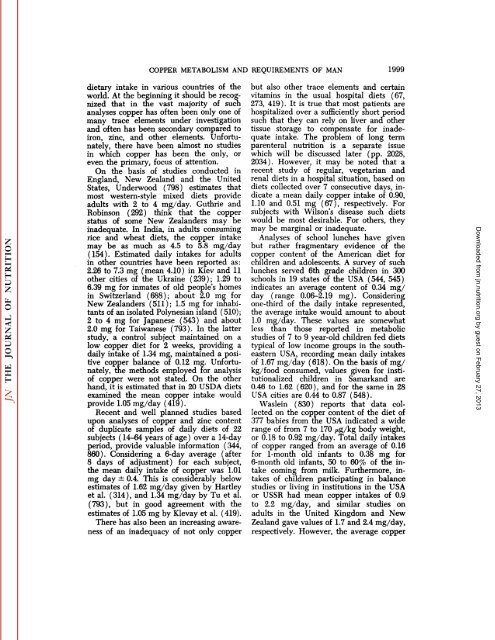conspectus of researchon copper metabolism and requirements
conspectus of researchon copper metabolism and requirements
conspectus of researchon copper metabolism and requirements
Create successful ePaper yourself
Turn your PDF publications into a flip-book with our unique Google optimized e-Paper software.
COPPER METABOLISM AND REQUIREMENTS OF MAN 1999<br />
dietary intake in various countries <strong>of</strong> the<br />
world. At the beginning it should be recog<br />
nized that in the vast majority <strong>of</strong> such<br />
analyses <strong>copper</strong> has <strong>of</strong>ten been only one <strong>of</strong><br />
many trace elements under investigation<br />
<strong>and</strong> <strong>of</strong>ten has been secondary compared to<br />
iron, zinc, <strong>and</strong> other elements. Unfortu<br />
nately, there have been almost no studies<br />
in which <strong>copper</strong> has been the only, or<br />
even the primary, focus <strong>of</strong> attention.<br />
On the basis <strong>of</strong> studies conducted in<br />
Engl<strong>and</strong>, New Zeal<strong>and</strong> <strong>and</strong> the United<br />
States, Underwood (798) estimates that<br />
most western-style mixed diets provide<br />
adults with 2 to 4 mg/day. Guthrie <strong>and</strong><br />
Robinson (292) think that the <strong>copper</strong><br />
status <strong>of</strong> some New Zeal<strong>and</strong>ers may be<br />
inadequate. In India, in adults consuming<br />
rice <strong>and</strong> wheat diets, the <strong>copper</strong> intake<br />
may be as much as 4.5 to 5.8 mg/day<br />
(154). Estimated daily intakes for adults<br />
in other countries have been reported as:<br />
2.26 to 7.3 mg (mean 4.10) in Kiev <strong>and</strong> 11<br />
other cities <strong>of</strong> the Ukraine (239); 1.29 to<br />
6.39 mg for inmates <strong>of</strong> old people's homes<br />
in Switzerl<strong>and</strong> (688); about 2.0 mg for<br />
New Zeal<strong>and</strong>ers (511); 1.5 mg for inhabi<br />
tants <strong>of</strong> an isolated Polynesian isl<strong>and</strong> (510);<br />
2 to 4 mg for Japanese (543) <strong>and</strong> about<br />
2.0 mg for Taiwanese (793). In the latter<br />
study, a control subject maintained on a<br />
low <strong>copper</strong> diet for 2 weeks, providing a<br />
daily intake <strong>of</strong> 1.34 mg, maintained a posi<br />
tive <strong>copper</strong> balance <strong>of</strong> 0.12 mg. Unfortu<br />
nately, the methods employed for analysis<br />
<strong>of</strong> <strong>copper</strong> were not stated. On the other<br />
h<strong>and</strong>, it is estimated that in 20 USDA diets<br />
examined the mean <strong>copper</strong> intake would<br />
provide 1.05 mg/day (419).<br />
Recent <strong>and</strong> well planned studies based<br />
upon analyses <strong>of</strong> <strong>copper</strong> <strong>and</strong> zinc content<br />
<strong>of</strong> duplicate samples <strong>of</strong> daily diets <strong>of</strong> 22<br />
subjects ( 14-64 years <strong>of</strong> age ) over a 14-day<br />
period, provide valuable information (344,<br />
860). Considering a 6-day average (after<br />
8 days <strong>of</strong> adjustment) for each subject,<br />
the mean daily intake <strong>of</strong> <strong>copper</strong> was 1.01<br />
mg day ±0.4. This is considerably below<br />
estimates <strong>of</strong> 1.62 mg/day given by Hartley<br />
et al. (314), <strong>and</strong> 1.34 mg/day by Tu et al.<br />
(793), but in good agreement with the<br />
estimates <strong>of</strong> 1.05 mg by Klevay et al. (419).<br />
There has also been an increasing aware<br />
ness <strong>of</strong> an inadequacy <strong>of</strong> not only <strong>copper</strong><br />
but also other trace elements <strong>and</strong> certain<br />
vitamins in the usual hospital diets (67,<br />
273, 419). It is true that most patients are<br />
hospitalized over a sufficiently short period<br />
such that they can rely on liver <strong>and</strong> other<br />
tissue storage to compensate for inade<br />
quate intake. The problem <strong>of</strong> long term<br />
parenteral nutrition is a separate issue<br />
which will be discussed later (pp. 2028,<br />
2034). However, it may be noted that a<br />
recent study <strong>of</strong> regular, vegetarian <strong>and</strong><br />
renal diets in a hospital situation, based on<br />
diets collected over 7 consecutive days, in<br />
dicate a mean daily <strong>copper</strong> intake <strong>of</strong> 0.90,<br />
1.10 <strong>and</strong> 0.51 mg (67), respectively. For<br />
subjects with Wilson's disease such diets<br />
would be most desirable. For others, they<br />
may be marginal or inadequate.<br />
Analyses <strong>of</strong> school lunches have given<br />
but rather fragmentary evidence <strong>of</strong> the<br />
<strong>copper</strong> content <strong>of</strong> the American diet for<br />
children <strong>and</strong> adolescents. A survey <strong>of</strong> such<br />
lunches served 6th grade children in 300<br />
schools in 19 states <strong>of</strong> the USA (544, 545)<br />
indicates an average content <strong>of</strong> 0.34 mg/<br />
day (range 0.06-2.19 mg). Considering<br />
one-third <strong>of</strong> the daily intake represented,<br />
the average intake would amount to about<br />
1.0 mg/day. These values are somewhat<br />
less than those reported in metabolic<br />
studies <strong>of</strong> 7 to 9 year-old children fed diets<br />
typical <strong>of</strong> low income groups in the south<br />
eastern USA, recording mean daily intakes<br />
<strong>of</strong> 1.67 mg/day (618). On the basis <strong>of</strong> mg/<br />
kg/food consumed, values given for insti<br />
tutionalized children in Samark<strong>and</strong> are<br />
0.46 to 1.62 (620), <strong>and</strong> for the same in 28<br />
USA cities are 0.44 to 0.87 (548).<br />
Waslein (830) reports that data col<br />
lected on the <strong>copper</strong> content <strong>of</strong> the diet <strong>of</strong><br />
377 babies from the USA indicated a wide<br />
range <strong>of</strong> from 7 to 170 /*g/kg body weight,<br />
or 0.18 to 0.92 mg/day. Total daily intakes<br />
<strong>of</strong> <strong>copper</strong> ranged from an average <strong>of</strong> 0.16<br />
for 1-month old infants to 0.38 mg for<br />
6-month old infants, 50 to 607o <strong>of</strong> the in<br />
take coming from milk. Furthermore, in<br />
takes <strong>of</strong> children participating in balance<br />
studies or living in institutions in the USA<br />
or USSR had mean <strong>copper</strong> intakes <strong>of</strong> 0.9<br />
to 2.2 mg/day, <strong>and</strong> similar studies on<br />
adults in the United Kingdom <strong>and</strong> New<br />
Zeal<strong>and</strong> gave values <strong>of</strong> 1.7 <strong>and</strong> 2.4 mg/day,<br />
respectively. However, the average <strong>copper</strong><br />
Downloaded from<br />
jn.nutrition.org<br />
by guest on February 27, 2013
















